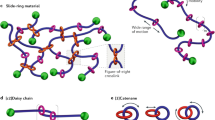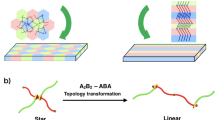Abstract
Entropic elasticity of single chains underlies many fundamental aspects of mechanical properties of polymers, such as high elasticity of polymer networks and viscoelasticity of polymer liquids. On the other hand, single chain elasticity is further rooted in chain connectivity. Recently, mechanically interlocked polymers, including polycatenanes and polyrotaxanes, which are formed by connecting their building blocks (cyclic and linear chains) through topological bonds (e.g., entanglements), emerge as a conceptually new kind of polymers. In this work, we employ computer simulations to study linear elasticity of single linear polycatenane (or [n]catenane), in which n rings are interlocked through catenation into a chain of linear architecture. Aim of this work is to illuminate the specific role of catenation topology in the elastic moduli of linear polycatenanes by comparing with those of their [n]bonded-ring counterparts, which are formed by connecting the same number of rings but via covalent bonds. Simulation results lead to a conclusion that topological catenation makes [n]catenanes exhibit larger elastic moduli than their linear and [n]bonded-ring counterparts, i.e., larger elastic moduli in the case of [n]catenanes. Furthermore, it is revealed that those [n]catenanes composed of a smaller number of rings (smaller n) possesses larger elastic moduli than others of the same total chain lengths. Molecular mechanisms of these findings are discussed based on conformational entropy due to topological constraints.
Similar content being viewed by others
References
Flory, P. J. in Principles of Polymer Chemistry. Cornell University Press, Ithaca, 1953.
de Gennes, P. G. in Scaling Concepts in Polymer Physics. Cornell University Press, Ithaca, 1979.
Doi, M.; Edwards, S. F. in The Theory of Polymer Dynamics. Oxford University Press, New York, 1986.
Grosberg, A. Y.; Khokhlov, A. R. in Statistical Physics of Macromolecules. AIP, New York, 1994.
Rubinstein, M.; Colby, R. H. in Polymer Physics. Oxford University Press, New York, 2003.
Wang, Z. G. 50th Anniversary perspective: polymer conformation: a pedagogical review. Macromolecules 2017, 50, 9073–9114.
Treloar, L. R. G. in The Physics of Rubber Elasticity. Oxford University Press, New York, 1975.
Wojtecki, R. J.; Meador, M. A.; Rowan, S. J. Using the dynamic bond to access macroscopically responsive structurally dynamic polymers. Nat. Mater. 2011, 10, 14.
Lehn, J. M. Perspectives in chemistry aspects of adaptive chemistry and materials. Angew. Chem. Int. Ed. 2015, 54, 3276–3289.
Zou, W.; Dong, J.; Luo, Y.; Zhao, Q.; Xie, T. Dynamic covalent polymer networks: from old chemistry to modern day innovations. Adv. Mater. 2017, 29, 1606100.
Chakma, P.; Konkolewicz, D. Dynamic covalent bonds in polymeric materials. Angew. Chem. Int. Ed. 2019, 58, 9682–9695.
Aida, T.; Meijer, E. W.; Stupp, S. I. Functional supramolecular polymers. Science 2012, 335, 813.
Yang, L.; Tan, X.; Wang, Z.; Zhang, X. Supramolecular polymers: historical development, preparation, characterization, and functions. Chem. Rev. 2015, 115, 7196–7239.
Webber, M. J.; Appel, E. A.; Meijer, E. W.; Langer, R. Supramolecular biomaterials. Nat. Mater. 2016, 15, 13.
Aida, T.; Meijer, E. W. Supramolecular polymers — we’ve come full circle. Isr. J. Chem. 2020, 60, 33–47.
Niu, Z.; Gibson, H. W. Polycatenanes. Chem. Rev. 2009, 109, 6024–6046.
Wu, Q.; Rauscher, P. M.; Lang, X.; Wojtecki, R. J.; de Pablo, J. J.; Hore, M. J. A.; Rowan, S. J. Poly[n]catenanes: synthesis of molecular interlocked chains. Science 2017, 358, 1434–1439.
Rauscher, P. M.; Rowan, S. J.; de Pablo, J. J. Topological effects in isolated poly[n]catenanes: molecular dynamics simulations and Rouse mode analysis. ACS Macro Lett. 2018, 7, 938–943.
Wu, Z. T.; Zhou, J. J. Mechanical Properties of Interlocked-ring Polymers: A Molecular Dynamics Simulation Study. Chinese J. Polym. Sci. 2019, 37, 1298–1304.
Rauscher, P. M.; Schweizer, K. S.; Rowan, S. J.; de Pablo, J. J. Thermodynamics and structure of poly[n]catenane melts. Macromolecules 2020, 53, 3390–3408.
Rauscher, P. M.; Schweizer, K. S.; Rowan, S. J.; de Pablo, J. J. Dynamics of poly[n]catenane melts. J. Chem. Phys. 2020, 152, 214901.
Zhang, G. J.; Zhang, J. G. Topological catenation induced swelling of ring polymers revealed by molecular dynamics simulation. Polymer 2020, 196, 122475.
Lei, H. Q.; Zhang, J. G.; Wang, L. M.; Zhang, G. J. Dimensional and shape properties of a single linear polycatenane: effect of catenation topology. Polymer 2021, 212, 123160.
Gibson, H. W.; Bheda, M. C.; Engen, P. T. Rotaxanes. catenanes, polyrotaxanes, polycatenanes and related materials. Prog. Polym. Sci. 1994, 19, 843–945.
Huang, F.; Gibson, H. W. Polypseudorotaxanes and polyrotaxanes. Prog. Polym. Sci. 2005, 30, 982–1018.
Harada, A.; Hashidzume, A.; Yamaguchi, H.; Takashima, Y. Polymericrotaxanes. Chem. Rev. 2009, 109, 5974–6023.
Arunachalam, M.; Gibson, H. W. Recent developments in polypseudorotaxanes and polyrotaxanes. Prog. Polym. Sci. 2014, 39, 1043–1073.
Hart, L. F.; Hertzog, J. E.; Rauscher, P. M.; Rawe, B. W.; Tranquilli, M. M.; Rowan, S. J. Material properties and applications of mechanically interlocked polymers. Nat. Rev. Mater. 2021, 6, 508–530.
Hudson, B.; Vinograd, J. Catenated circular DNA molecules in Hela cell mitochondria. Nature 1967, 216, 647–652.
Clayton, D. A.; Vinograd, J. Circular dimer and catenate forms of mitochondrial DNA, n-Human leukaemic leucocytes. Nature 1967, 216, 652–657.
Liang, C.; Mislow, K. Knots in proteins. J. Am. Chem. Soc. 1994, 116, 11189–11190.
Wikoff, W. R.; Liljas, L.; Duda, R. L.; Tsuruta, H.; Hendrix, R. W.; Johnson, J. E. Topologically linked protein rings in the bacteriophage HK97 capsid. Science 2000, 289, 2129–2133.
Zhou, H. X. Effect of catenation on protein folding stability. J. Am. Chem. Soc. 2003, 125, 9280–9281.
Lee, B. I.; Kim, K. H.; Park, S. J.; Eom, S. H.; Song, H. K.; Suh, S. W. Ring-shaped architecture of RecR: implications for its role in homologous recombinational DNA repair. EMBO J. 2004, 23, 2029–2038.
Cao, Z.; Roszak, A. W.; Gourlay, L. J.; Lindsay, J. G.; Isaacs, N. W. Bovine mitochondrial peroxiredoxin III forms a two-ring catenane. Structure 2005, 13, 1661–1664.
Boutz, D. R.; Cascio, D.; Whitelegge, J.; Perry, L. J.; Yeates, T. O. Discovery of a thermophilic protein complex stabilized by topologically interlinked chains. J. Mol. Biol. 2007, 368, 1332–1344.
Zimanyi, C. M.; Ando, N.; Brignole, E. J.; Asturias, F. J.; Stubbe, J.; Drennan, C. L. Tangled up in knots: structures of inactivated forms of E. coli class Ia ribonucleotide reductase. Structure 2012, 20, 1374–1383.
van Eldijk, M. B.; van Leeuwen, I.; Mikhailov, V. A.; Neijenhuis, L.; Harhangi, H. R.; van Hest, J. C. M.; Jetten, M. S. M.; den Camp, H. J. M. O.; Robinson, C. V.; Mecinovic, J. Evidence that the catenane form of CS2 hydrolase is not an artefact. Chem. Commun. 2013, 49, 7770.
Aguirre, C.; Goto, Y.; Costas, M. Thermal and chemical unfolding pathways of PaSdsA1 sulfatase. A homo-dimer with topologically interlinked chains. FEBS Lett. 2016, 590, 202–214.
Pieters, B. J.; van Eldijk, M. B.; Nolte, R. J.; Mecinovic, J. Natural supramolecular protein assemblies. Chem. Soc. Rev. 2016, 45, 24–39.
Dominguez-Gil, T.; Molina, R.; Dik, D. A.; Spink, E.; Mobashery, S.; Hermoso, J. A. X-ray structure of catenated lytic transglycosylase SltB1. Biochemistry 2017, 56, 6317–6320.
Wang, X. W.; Zhang, W. B. Protein catenation enhances both the stability and activity of folded structural domains. Angew. Chem. Int. Ed. 2017, 56, 13985–13989.
Zhao, Y.; Cieplak, M. Stability of structurally entangled protein dimers. Proteins 2018, 86, 945–955.
Hoffman, B. D.; Grashoff, C.; Schwartz, M. A. Dynamic molecular processes mediate cellular mechanotransduction. Nature 2011, 475, 316.
Hsua, H. P. and Binder, K. Stretching semiflexible polymer chains: evidence for the importance of excluded volume effects from Monte Carlo simulation. J. Chem. Phys. 2012, 136, 024901.
Saleh, O. A. Perspective: single polymer mechanics across the force regimes. J. Chem. Phys 2015, 142, 194902.
Pincus, P. Excluded volume effects and stretched polymer chains. Macromolecules 1976, 9, 386.
Marko, J. F.; Siggia, E. D. Stretching DNA. Macromolecules 1995, 28, 8759.
Bustamante, C.; Marko, J. F.; Siggia, E. D.; Smith, S. Entropic elasticity of X-phage DNA. Science 1994, 265, 1599.
Dutta, S. and Sing, C. E. Two stretching regimes in the elasticity of bottlebrush polymers. Macromolecules 2020, 53, 6946–6955.
Pakula, T.; Jeszka, K. Simulation of single complex macromolecules. 1. Structure and dynamics of catenanes. Macromolecules 1999, 32, 6821–6830.
Liu, G.; Rauscher, P. M.; Rawe, B. W.; Tranquilli, M. M.; Rowan, S. J. Polycatenanes: synthesis, characterization, and physical understanding. Chem. Soc. Rev. 2022, 51, 4928.
Li, J.; Gu, F.; Yao, N.; Wang, H.; Liao, Q. Double asymptotic structures of topologically interlocked molecules. ACS Macro Lett. 2021, 10, 1094–1098.
Chiarantoni, P. and Micheletti, C. Effect of ring rigidity on the statics and dynamics of linear catenanes. Macromolecules 2022, 55, 4523–4532.
Hagita, K.; Murashima, T.; and Sakata, N. Mathematical classification and rheological properties of ring catenane structures. Macromolecules 2022, 55, 166–177.
Kremer, K.; Grest, G. S. Dynamics of entangled linear polymer melts: a molecular-dynamics simulation. J. Chem. Phys. 1990, 92, 5057.
Zhang, G. J.; Moreira, L. A.; Stuehn, T.; Daoulas, K. Ch.; Kremer, K. Equilibration of high molecular weight polymer melts:a hierarchical strategy. ACS Macro Lett. 2014, 3, 198–203.
Zhang, G. J.; Stuehn, T.; Daoulas, K. Ch.; Kremer, K. Communication:one size fits all: Equilibrating chemically different polymer liquids through universal long-wavelength description. J. Chem. Phys. 2015, 142, 221102.
Moreira, L. A.; Zhang, G. J.; Muller, F.; Stuehn, T.; Kremer, K. Direct equilibration and characterization of polymer melts for computer simulations. Macromol. Theory Simul. 2015, 24, 419–431.
Zhang, G. J.; Chazirakis, A.; Harmandaris, V. A.; Stuehn, T.; Daoulas, K. Ch.; Kremer, K. Hierarchical modelling of polystyrene melts: from soft blobs to atomistic resolution. Soft Matter 2019, 15, 289.
Smrek, J.; Kremer, K.; Rosa, A. Threading of unconcatenated ring polymers at high concentrations: double-folded vs time-equilibrated structures. ACS Macro Lett. 2019, 8, 155–160.
Halverson, J. D.; Lee, W. B.; Grest, G. S.; Grosberg, A. Y.; Kremer, K. Molecular dynamics simulation study of non-concatenated ring polymers in a melt. I. Statics. J. Chem. Phys. 2011, 134, 204904.
Halverson, J. D.; Lee, W. B.; Grest, G. S.; Grosberg, A. Y.; Kremer, K. Molecular dynamics simulation study of non-concatenated ring polymers in a melt. II. Dynamics. J. Chem. Phys. 2011, 134, 204905.
Cai, X.; Liang, C.; Liu, H.; Zhang, G. J. Conformation and structure of ring polymers in semidilute solutions: A molecular dynamics simulation study. Polymer 2022, 253, 124953.
Recently, Dutta and Benetatos considered an interesting question, whether results from these two ensemble simulations for single chain elasticity, i.e., constant-force simulation and constant-extension simulation are equivalent, finally concluded that there is an inequivalence of the constant-force and the constant-extension ensembles for studying single chain elasticity of polymers. A possible reason underlying this finding could be lack of a well-defined thermodynamic limit for the single chain systems. while it is not a problem in the conventional macroscopic systems. Dutta, S.; Benetatos, P. Soft Matter 2018, 14, 6857.
Strobl, G. in The Physics of Polymers. Springer, 2007.
Acknowledgments
It is a great pleasure to thank Dr. Jianguo Zhang and Dr. Jiajia Zhou for useful discussion. This work was financially supported by the National Natural Science Foundation of China (No. 21873023).
Author information
Authors and Affiliations
Corresponding author
Ethics declarations
The authors declare no competing financial interest.
Rights and permissions
About this article
Cite this article
Chen, YX., Cai, XQ. & Zhang, GJ. Topological Catenation Enhances Elastic Modulus of Single Linear Polycatenane. Chin J Polym Sci 41, 1486–1496 (2023). https://doi.org/10.1007/s10118-023-2902-x
Received:
Accepted:
Published:
Issue Date:
DOI: https://doi.org/10.1007/s10118-023-2902-x




